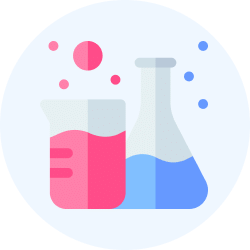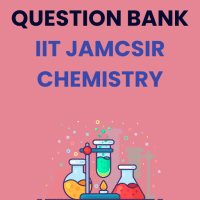Chemistry Exam > Chemistry Questions > In fructose the possible optical iso mer are:...
Start Learning for Free
In fructose the possible optical iso mer are:
Correct answer is '8'. Can you explain this answer?
Most Upvoted Answer
In fructose the possible optical iso mer are:Correct answer is '8'. Ca...
Fructose is a monosaccharide or simple sugar that is found in many fruits, vegetables and honey. It has the chemical formula C6H12O6 and is an important source of energy for the body. When fructose is dissolved in water, it can exist in different forms or isomers, depending on the spatial arrangement of its atoms.
Possible Optical Isomers of Fructose
Fructose has four chiral carbon atoms, which means that it can have up to 2^4 or 16 possible stereoisomers. However, not all of these isomers are optically active or have the ability to rotate plane-polarized light. Only those isomers that are non-superimposable mirror images of each other are optically active and are called enantiomers or optical isomers.
Fructose exists in two main forms: alpha fructose and beta fructose. These two forms differ in the orientation of their hydroxyl groups around the anomeric carbon atom, which is the carbon atom that is bonded to both an oxygen atom and another carbon atom. Alpha fructose has its hydroxyl group pointing downwards, while beta fructose has its hydroxyl group pointing upwards.
Each of these forms can exist in two possible configurations, depending on the orientation of the hydroxyl groups around the other three chiral carbon atoms. These configurations are designated as either D or L, depending on the orientation of the hydroxyl group on the last chiral carbon atom. Therefore, fructose can exist in four possible isomers: alpha-D-fructose, alpha-L-fructose, beta-D-fructose, and beta-L-fructose.
Each of these four isomers can exist in two possible enantiomeric forms, depending on whether the molecule is a right-handed or left-handed form. Therefore, fructose can exist in eight possible optical isomers: alpha-D-fructose, alpha-L-fructose, beta-D-fructose, beta-L-fructose, (alpha-D)-fructose, (alpha-L)-fructose, (beta-D)-fructose, and (beta-L)-fructose.
Conclusion
In summary, fructose has eight possible optical isomers, which are determined by the orientation of its hydroxyl groups around its four chiral carbon atoms. These isomers are important for understanding the biological activity and metabolism of fructose, as well as for the production of pure fructose for use in food and pharmaceutical applications.
Possible Optical Isomers of Fructose
Fructose has four chiral carbon atoms, which means that it can have up to 2^4 or 16 possible stereoisomers. However, not all of these isomers are optically active or have the ability to rotate plane-polarized light. Only those isomers that are non-superimposable mirror images of each other are optically active and are called enantiomers or optical isomers.
Fructose exists in two main forms: alpha fructose and beta fructose. These two forms differ in the orientation of their hydroxyl groups around the anomeric carbon atom, which is the carbon atom that is bonded to both an oxygen atom and another carbon atom. Alpha fructose has its hydroxyl group pointing downwards, while beta fructose has its hydroxyl group pointing upwards.
Each of these forms can exist in two possible configurations, depending on the orientation of the hydroxyl groups around the other three chiral carbon atoms. These configurations are designated as either D or L, depending on the orientation of the hydroxyl group on the last chiral carbon atom. Therefore, fructose can exist in four possible isomers: alpha-D-fructose, alpha-L-fructose, beta-D-fructose, and beta-L-fructose.
Each of these four isomers can exist in two possible enantiomeric forms, depending on whether the molecule is a right-handed or left-handed form. Therefore, fructose can exist in eight possible optical isomers: alpha-D-fructose, alpha-L-fructose, beta-D-fructose, beta-L-fructose, (alpha-D)-fructose, (alpha-L)-fructose, (beta-D)-fructose, and (beta-L)-fructose.
Conclusion
In summary, fructose has eight possible optical isomers, which are determined by the orientation of its hydroxyl groups around its four chiral carbon atoms. These isomers are important for understanding the biological activity and metabolism of fructose, as well as for the production of pure fructose for use in food and pharmaceutical applications.
Free Test
FREE
| Start Free Test |
Community Answer
In fructose the possible optical iso mer are:Correct answer is '8'. Ca...
Number of chiral centres = 3. No. of optical isomers = 2^3 = 8.

|
Explore Courses for Chemistry exam
|

|
Question Description
In fructose the possible optical iso mer are:Correct answer is '8'. Can you explain this answer? for Chemistry 2025 is part of Chemistry preparation. The Question and answers have been prepared according to the Chemistry exam syllabus. Information about In fructose the possible optical iso mer are:Correct answer is '8'. Can you explain this answer? covers all topics & solutions for Chemistry 2025 Exam. Find important definitions, questions, meanings, examples, exercises and tests below for In fructose the possible optical iso mer are:Correct answer is '8'. Can you explain this answer?.
In fructose the possible optical iso mer are:Correct answer is '8'. Can you explain this answer? for Chemistry 2025 is part of Chemistry preparation. The Question and answers have been prepared according to the Chemistry exam syllabus. Information about In fructose the possible optical iso mer are:Correct answer is '8'. Can you explain this answer? covers all topics & solutions for Chemistry 2025 Exam. Find important definitions, questions, meanings, examples, exercises and tests below for In fructose the possible optical iso mer are:Correct answer is '8'. Can you explain this answer?.
Solutions for In fructose the possible optical iso mer are:Correct answer is '8'. Can you explain this answer? in English & in Hindi are available as part of our courses for Chemistry.
Download more important topics, notes, lectures and mock test series for Chemistry Exam by signing up for free.
Here you can find the meaning of In fructose the possible optical iso mer are:Correct answer is '8'. Can you explain this answer? defined & explained in the simplest way possible. Besides giving the explanation of
In fructose the possible optical iso mer are:Correct answer is '8'. Can you explain this answer?, a detailed solution for In fructose the possible optical iso mer are:Correct answer is '8'. Can you explain this answer? has been provided alongside types of In fructose the possible optical iso mer are:Correct answer is '8'. Can you explain this answer? theory, EduRev gives you an
ample number of questions to practice In fructose the possible optical iso mer are:Correct answer is '8'. Can you explain this answer? tests, examples and also practice Chemistry tests.

|
Explore Courses for Chemistry exam
|

|
Signup for Free!
Signup to see your scores go up within 7 days! Learn & Practice with 1000+ FREE Notes, Videos & Tests.


















